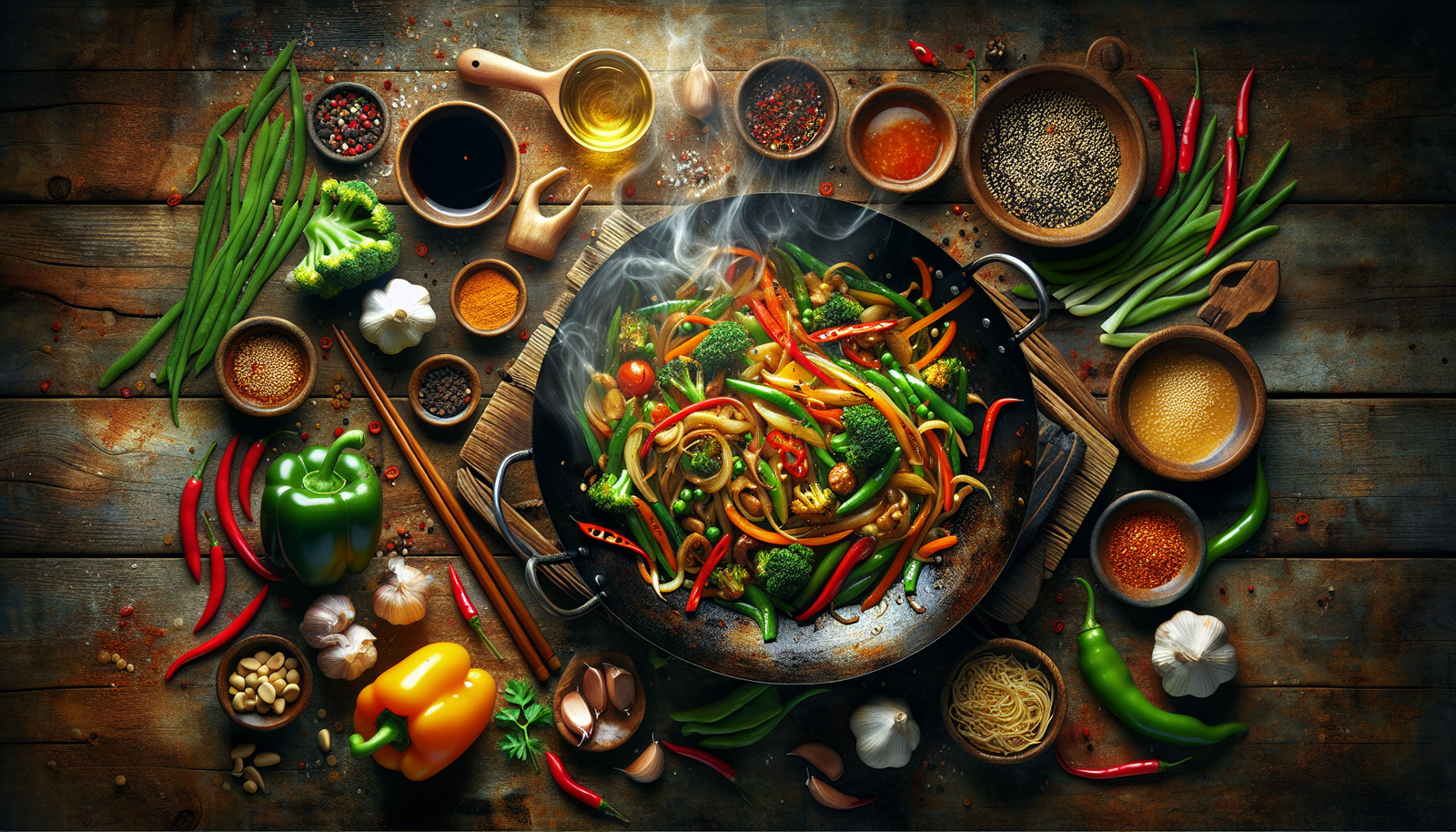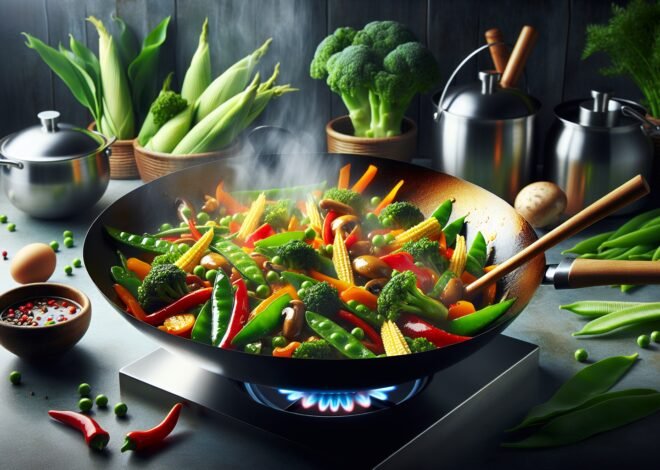
How to Add Spices and Flavors to Stir-Fry for an Extra Kick
Adding spices to stir-fry can transform a simple meal into a vibrant culinary experience. Did you know that the right spices can enhance not only the taste but also the aroma and visual appeal of your dish? This guide will explore how to select and use spices effectively to add an extra kick to your stir-fry. From classic staples like ginger and garlic to exotic options like star anise and Sichuan pepper, we’ll cover various spice profiles and provide tips to balance flavors. By the end, you’ll have the tools to elevate your stir-fry creations to new and delicious heights.
Choosing the Right Spices for Stir-Fry Dishes
Selecting spices for stir-fry can transform a simple dish into an extraordinary flavor experience. This section will guide you through common Asian spices, balancing them for exquisite taste, and the pros and cons of fresh versus dried spices.
Exploring Common Asian Spices for Stir-Fry
Asian cuisine is renowned for its rich and diverse use of spices. Understanding these can elevate your stir-fry game. Here are some essential spices to consider:
– **Ginger**: Offers a warm, slightly spicy note. It’s a staple in many Asian dishes.
– **Garlic**: Provides a robust aroma and flavor. Pairs well with most ingredients.
– **Sichuan Peppercorns**: Adds a unique, numbing heat. Perfect for authentic Chinese dishes.
– **Turmeric**: Infuses a vibrant color and mild earthy taste. Often used in Southeast Asian cooking.
– **Five-Spice Powder**: A blend of star anise, cloves, Chinese cinnamon, Sichuan pepper, and fennel seeds. Balances sweet, salty, and bitter flavors.
Each spice has distinct characteristics that can enhance your dish in different ways. Experiment with combinations to find what suits your palate.
How to Balance Spices for Optimal Flavor
Balancing spices is key to achieving a harmonious stir-fry. Here’s how you can master this art:
1. **Start Small**: Use a light hand with potent spices like Sichuan peppercorns or cloves.
2. **Taste as You Cook**: Continually tasting allows you to adjust flavors as needed.
3. **Contrast and Complement**: Pair spices that contrast each other, like sweet and spicy, or complement, like garlic and ginger.
4. **Layering**: Add spices at different cooking stages to build depth.
Achieving balance means finding the right mix of boldness and subtlety, creating a delightful experience with every bite.
Using Fresh vs. Dried Spices in Stir-Fry
Fresh and dried spices each bring unique benefits and challenges to stir-fry dishes:
– **Fresh Spices**: Offer vibrant aromas and flavors. They can be more aromatic but may require preparation, like peeling or chopping.
– **Dried Spices**: Convenient and long-lasting. They often have concentrated flavors, so using smaller amounts is key.
Consider the texture and cooking time of your dish when choosing between fresh and dried. Fresh spices are ideal for quick toss-ins, while dried ones suit longer stews.
Techniques for Incorporating Flavors in Stir-Fry
Techniques for infusing flavors go beyond just adding spices. This section explores methods to enhance aroma and taste, from toasting spices to creating homemade blends and layering with oils and sauces.
How to Toast Spices for Stir-Fry Aromas
Toasting spices is a simple technique that unlocks deep flavors and aromas:
1. **Heat a Pan**: Use a dry skillet over medium heat.
2. **Add Spices**: Toss in whole spices like cumin or coriander seeds.
3. **Stir Constantly**: Keep them moving to prevent burning.
4. **Watch for Change**: Toast until they’re fragrant and slightly darker.
Toasted spices can be ground to a powder, adding a new dimension to your stir-fry that pre-ground spices can’t match.
Creating Homemade Spice Blends for Stir-Fry
Crafting your spice blends gives you control over flavor profiles:
– **Spice Mixes**: Combine spices like cumin, coriander, and turmeric for a curry-inspired blend.
– **Personal Touch**: Customize to your liking, perhaps adding more heat or sweetness.
– **Storage**: Keep your blend in an airtight container to maintain freshness.
Homemade blends are exciting to experiment with, offering a personalized touch to every meal.
Layering Flavors with Oils, Sauces, and Spices
Layering flavors is an art that can bring complexity to your stir-fry:
1. **Choose Your Oil**: Sesame or peanut oil add nutty undertones.
2. **Sauté Aromatics**: Begin with garlic or onions in hot oil.
3. **Add Sauces**: Soy sauce or oyster sauce contribute umami richness.
4. **Final Spices**: Finish with a sprinkle of your spice blend or fresh herbs.
This technique ensures that each ingredient contributes to the overall flavor, creating a cohesive and delicious dish.
Enhancing Stir-Fry with Unique Flavors
Elevate your stir-fry by introducing unique flavors that surprise and delight. This section explores using citrus, herbs, and fermented ingredients for an unexpected twist.
Adding Citrus Zest and Juices to Stir-Fry
Citrus can brighten and refresh your stir-fry:
– **Lemon or Lime Zest**: Grate over the finished dish for a vibrant aroma.
– **Citrus Juices**: Squeeze a bit of lemon or orange juice for a tangy finish.
– **Balance**: Use citrus to cut through rich flavors or add brightness.
The acidity and zest can elevate your dish, making it more dynamic and appealing.
Infusing Stir-Fry with Herb and Spice Combos
Herbs bring fresh, bright notes that contrast with spices:
– **Basil and Mint**: Perfect for lighter, summery dishes.
– **Cilantro and Parsley**: Add a burst of freshness.
– **Thyme and Rosemary**: Provide a more robust, earthy flavor.
Mixing herbs with spices creates complex layers, enhancing the overall taste profile.
Using Fermented Ingredients for Depth in Stir-Fry
Fermented ingredients add depth and umami, enriching the dish:
– **Soy Sauce**: Classic for its deep, savory notes.
– **Kimchi**: Offers a spicy, tangy kick.
– **Miso Paste**: Adds a rich, savory undertone.
These ingredients can transform a simple stir-fry into a bold, memorable meal. Integrating them thoughtfully can result in a dish that’s flavorful and satisfying.
This guide provides insights into transforming your stir-fry with carefully chosen spices and innovative techniques. Each section offers a treasure trove of ideas to enrich your culinary journey.
Conclusion
Stir-frying is a quick and versatile cooking method that benefits significantly from the addition of spices. Ginger and garlic are commonly used for their rich flavors and aromatic qualities. Combining soy sauce with other spices like chili flakes or five-spice powder enhances taste complexity. Toasted sesame oil can be added for a nutty aroma. Fresh herbs like cilantro or basil serve as a garnish to elevate the dish’s freshness and visual appeal.
“`html
FAQ
What are the best spices to use in a stir-fry for enhanced flavor?
The ideal spices for a flavorful stir-fry include garlic, ginger, and chilies. Add soy sauce, sesame oil, and a dash of white pepper for depth. These spices create a savory base with a hint of heat.
How can I incorporate spices into stir-fry dishes to achieve a balanced taste?
Begin by heating spices in oil to release their flavors before adding vegetables or protein. Layer spices gradually, tasting as you go. Balance strong flavors with milder ones to ensure harmony in each bite.
What is the most common mistake when adding spices to stir-fry recipes?
Overusing strong spices can overwhelm the dish. Introduce spices in moderation and balance them with fresh ingredients. This preserves the dish’s natural flavors while enhancing them with spice.
What spices are recommended for authentic Asian stir-fry aromas?
Opt for staple Asian spices such as star anise, Sichuan peppercorns, and five-spice powder. These create traditional aromas that elevate the stir-fry experience.
When should you add spices to a stir-fry for optimal flavor infusion?
Add spices at the start while heating oil to bloom their flavors. Additional seasoning can be incorporated near the end to adjust taste. This method ensures a deep, rich flavor profile.
Can you suggest a spice combination that works well for a vegetarian stir-fry?
Combine turmeric, cumin, and coriander for a warm, earthy flavor. Pair with curry leaves and mustard seeds for an aromatic touch, perfect for a vibrant vegetarian dish.
“`











